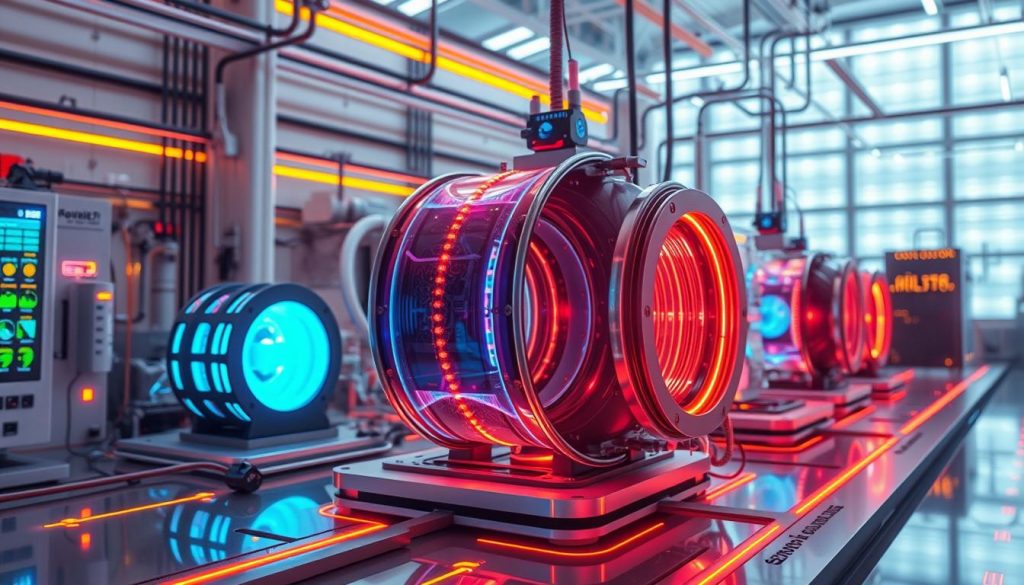Room-temperature superconductors: What this means for the future of energy.
Room-temperature superconductors are a big leap in science, changing how we think about energy. They let electricity move freely at room temperature, making energy use more efficient. This could lead to big savings in costs for many industries.
Anúncios
With new materials like LK-99, we might see energy losses almost gone. This could make power grids up to 20% more efficient. It could also change how we use energy in transport and computing.
Understanding Superconductors
Superconductors are materials that can carry electricity without resistance. They work best at very low temperatures. At these temperatures, electrons form Cooper pairs and move smoothly, making them great conductors.
Unlike copper and aluminum, superconductors don’t lose much energy. This is because they don’t have resistance. In fact, about 5% of power is lost during transmission. This loss costs around US$6 billion in the U.S. each year.
Superconductors can carry more electricity than current cables. They work well even at room temperature. This makes them very promising for the future of electronics and energy.
Anúncios
Superconductivity was first found in 1911 in mercury at -269°C. The Bardeen-Cooper-Schrieffer (BCS) theory explained it in 1957. It shows how superconductors could change our energy future.
As electricity use grows, superconductors could be key. They could help us use energy more efficiently and sustainably.
The History of Superconductors
In 1911, Heike Kamerlingh Onnes found superconductivity in mercury at very low temperatures. He noticed mercury wire’s electrical resistance dropped by thousands of times. This discovery opened a new area in physics.
The Bardeen-Cooper-Schrieffer theory came in 1957, explaining how electricity flows without resistance. It focused on how electrons pair up. This theory won the Nobel Prize in Physics in 1972.
In the 1980s, scientists found high-temperature superconductors. Materials like lanthanum copper oxide could conduct electricity at higher temperatures than before. This led to more research and hopes for room-temperature superconductors.
Over time, scientists learned more about superconductors. The Meissner effect in 1933 showed they are perfect diamagnets. Each finding deepened our understanding of superconductors and how they work.
Room-Temperature Superconductors: A Breakthrough
The search for room-temperature superconductors is a big deal in scientific research. LK-99 has made headlines, suggesting it could work at 30°C (86°F). This is exciting because it shows a huge drop in resistance, from positive at 105°C (221°F) to almost zero at room temperature.

Making LK-99 involved heating a mix of powdered compounds for hours. Seeing the Meissner effect in LK-99 supports its superconductivity claims. But, publishing the findings first on arXiv without peer review raised doubts about its credibility.
Despite doubts, scientists worldwide are still exploring compounds like LK-99. They hope to confirm and repeat its promising results. For over a century, finding reliable room-temperature superconductors has been a challenge. Advances in materials science could lead to big changes in energy and transport tech.
But, there’s still a lot of skepticism. The magnetic field and heat capacity measurements are under close watch. Past claims of superconductivity at similar temperatures have often been retracted or found to be fake. This makes the story of LK-99 and its role in scientific research even more complex.
| Key Data on LK-99 | Measurements and Outcomes |
|---|---|
| Temperature for Superconductivity | 30°C (86°F) |
| Resistivity Decrease | Sharp decline from 105°C (221°F) to nearly zero at 30°C (86°F) |
| Heating Process | Mixture of powdered compounds heated for several hours |
| Meissner Effect | Observed in LK-99 sample |
| Publication Status | Initial findings uploaded to arXiv without peer review |
The quest for room-temperature superconductors keeps scientists hopeful. If breakthroughs like LK-99 happen, they could change how we use energy and technology.
The Science Behind Room-Temperature Superconductivity
Room-temperature superconductivity is a dream for scientists. It could change how we handle energy. Metal hydrides, like yttrium decahydride (YH10), are key players. They need very high pressure to become superconductors, showing us new things about electron-phonon interactions.
It’s important to know how these interactions help superconductivity work. BCS theory says they help form Cooper pairs, which are vital for superconductivity. A new material, Pb10-xCux(PO4)6O, shows superconductivity at 127°C without needing high pressure. This is a big step forward because it doesn’t switch to an insulator, keeping conductivity.
Scientists are working hard to find materials with higher critical temperatures. The first superconductivity was found in mercury at -269°C. But, new discoveries suggest that metal hydrides might work at much warmer temperatures. This could bring us closer to achieving room-temperature superconductivity.
Potential Applications of Room-Temperature Superconductors
The discovery of room-temperature superconductors has sparked a lot of excitement. They could change how we use energy, make processes smoother, and boost performance in many areas.
One exciting area is energy efficiency. Superconductors could send energy without losing any, cutting down the 5% loss in the US. This could save money and help the environment.
In transportation, superconductors could make trains move much faster. They could reach speeds that regular trains can’t. This would make travel faster and cheaper.
Superconductors also have a big impact on medical technology. They could make MRI machines smaller and cheaper. This could help doctors diagnose faster and more easily.
In quantum computing, superconductors are key. They help make quantum computers work better. Room-temperature superconductors could make these computers even faster and more efficient.
In short, room-temperature superconductors open up many new possibilities. They could make energy use more efficient and lead to new solutions for our daily lives.
For more on this exciting topic, check out recent research here.
Challenges in Achieving Room-Temperature Superconductivity
The search for room-temperature superconductivity is tough. It needs new ideas to overcome challenges in superconductivity. For over a century, scientists have faced many research hurdles. One big problem is finding the right temperature and pressure conditions for superconductivity.
High pressures, millions of times our atmosphere, are often needed. This is because materials need to be under extreme conditions to become superconductors.
Keeping materials pure is also key. Even tiny impurities can ruin the superconductivity process. The shape of the materials matters too. They need to be arranged in a way that helps create Cooper pairs, the heart of superconductivity.
Recent discoveries have shown promise. Some materials might become superconductors at temperatures above 0 °C. But, using these in everyday life is still a dream. For example, hydrogen-rich superconductors have sparked excitement. Yet, making them work in real-world conditions is a big challenge.
Scientists face many obstacles in their quest for superconductivity. They must keep working together to find solutions. To learn more, check out the challenges in superconductivity that scientists are tackling.

The Impact on Modern Technology and Energy Efficiency
Superconductors have a huge impact on modern technology. They make energy use more efficient and improve how we send electricity. Since they don’t lose energy as heat, they help devices work better and infrastructure get stronger.
New superconductor tech, like High-Temperature Superconductors (HTS), works with liquid nitrogen. This has led to cool tech like Japan’s SCMaglev train. It goes over 600 km/h, much faster than old trains.
In healthcare, superconductors make MRI machines better. They do scans faster and with clearer images. Also, superconducting power lines are being tested. They could save money and make the grid more reliable.
Superconductors could change how we use energy. They can store energy quickly and efficiently. Superconducting transformers and converters could be over 99.9% efficient. This could change how we distribute energy.
To show how superconductors have changed, here’s a table:
| Type of Superconductor | Critical Temperature (Tc) | Application | Energy Efficiency Impact |
|---|---|---|---|
| Low-Temperature Superconductors (LTS) | Below 4K | CERN’s Large Hadron Collider | Zero resistance, high energy consumption for cooling |
| High-Temperature Superconductors (HTS) | Up to 138K | SCMaglev train | Significantly reduces travel time |
| Room-Temperature Superconductors (Proposed) | Above 273K | Innovative energy grids, advanced computing | Potential for zero cooling costs and energy loss |
Superconducting tech is getting better. It could make energy use even more efficient. If we get room-temperature superconductors, it could change how we use energy a lot.
Room-Temperature Superconductors vs. Traditional Conductors
The debate between superconductors and conductors goes beyond simple definitions. It dives into deep differences in electrical behavior and energy efficiency. Traditional conductors like copper lose energy as their resistance causes heat, especially at higher temperatures. This efficiency comparison shows big problems in power distribution, leading to a lot of energy waste.
Room-temperature superconductors aim for a big change by removing electrical resistance. They promise a fully efficient system that works at or above 20°C, improving energy use. Traditional superconductors need very low temperatures to work, making them hard to use in everyday life.
A detailed materials comparison is key in these talks. It looks at the structure and critical temperatures of different materials. While old superconductors like lanthanum barium copper oxide work at low temperatures, new research points to hydrogen-rich compounds for room-temperature superconductivity. As research goes on, making superconductive materials practical gets closer.
While traditional conductors have their benefits, like being well-known and available, room-temperature superconductors could change everything. They suggest systems with almost no energy loss. Knowing these differences is crucial for the future of energy efficiency in many areas.
Conclusion
Room-temperature superconductors are changing the energy world. They show us a future where electricity flows freely. This could greatly change how we use energy, making it more sustainable.
These superconductors could make energy use more efficient. They might even change how we travel and do medical tests. This could lead to big savings and new ways to use technology.
The future of superconductors is exciting and full of possibilities. They could make our energy use more efficient and sustainable. New discoveries in this area could lead to even more amazing technologies we can’t yet imagine.
